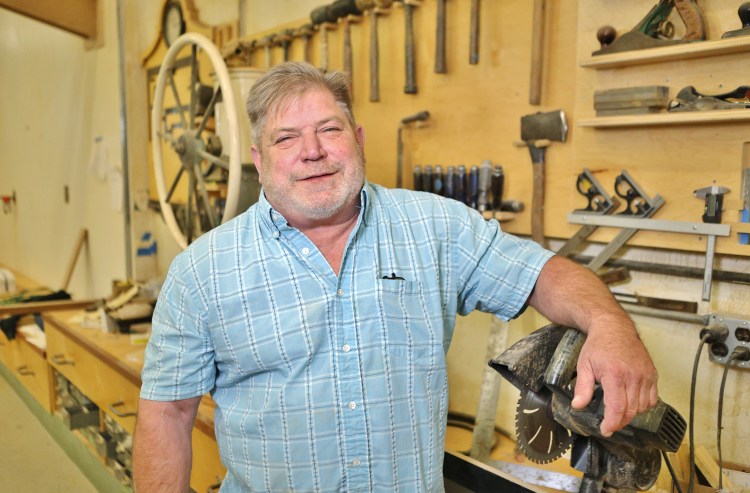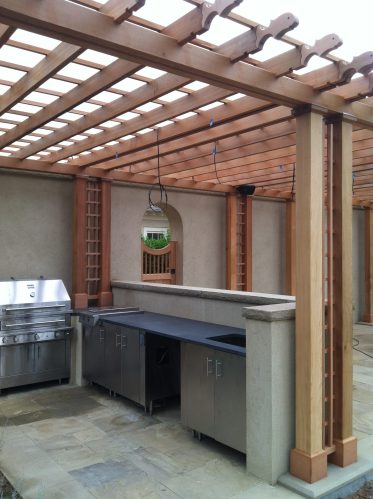Scott Woodrick walks through a maze of machinery, wood and samples in his 6,000-square-foot shop in Bay Shore. The owner of Unique Wood Statements,
a high-end woodworking shop, he shows a few projects and planks ready to be transformed into future furniture. Maybe it makes sense that during the tour, the perfect song begins to play, as the Beatles’ “Nothing’s Gonna Change My World” pipes in through the well-ventilated space.
“I’m a traditionalist, but I take modern glues, epoxies and old-style joinery,” Woodrick says. “I apply what’s modern that’s better.”
Scott Woodrick (he even has “wood” in his name and used to live on Cedarwood Street in Islip) is the consummate wood craftsman. Leading Unique Wood Statements since 1988, he has created the bars at many of the region’s best restaurants, as well as residential kitchens, pergolas, tables, chairs and a wide range of work for commercial clients often on the East End, but across Long Island, New York City and nationwide from California to Georga, Las Vegas to Los Angeles.

“I’m a much better woodworker than in the past,” Woodrick, 58, says. “I learn every day. I never do the same thing. Everything is a one-off. Everything is different.”
Being a craftsman, Woodrick says, is a combination of skill and attention to specifics, attitude and aptitude, patience and pride. “It’s a concept, a mental thing. Like a Grateful Dead concert, you get into it,” he says. “You forget about everything else except what you’re working on.”
He says he often is assigned the “more complicated stuff, the more artistic” where you “have to work hard on the details.” Ask him how he learned, and he answers one word: Osmosis. He was taught before tech became everybody’s tutor.
“There was no such thing as YouTube or cellphones when I was growing up,” he says. “There was trial and error, boat building, steaming wood, laminating wood.”
He goes beyond the ordinary, in his youth doing dangerous things to transport large pieces of wood into apartments when they wouldn’t fit in elevators.
“We would take out the emergency hatch of freight elevators,” he says. “I would ride on the top of the elevator with long lengths of wood, because they wouldn’t fit in the elevator.”
A careful craftsman today, he doesn’t allow cell phone use in his shop. A second of distraction can be dangerous. “Everything in my shop bites,” he says.

Wood in His Blood
Woodrick says his great grandfathers were woodsmiths, and his father was a submarine commander, leading to an interest in boats and then building boats. “The first boat I built, I was probably in fifth grade. My dad helped me launch it. It capsized,” Woodrick says. “He told me woodworking was in my blood. So I continued doing it.”
He attended Texas Maritime, a division of Texas A&M, but didn’t graduate, since they hiked tuition, instead going into woodworking. Woodrick worked for Gerald Frost, AKA Jack Frost, and at the Brewster Shipyard in Bay Shore before going out alone.
Then his boat came in.
In his 20s, Woodrick was hired to build a teak pool deck for a Manhattan penthouse. The client turned out to be David Bowie. “They called boatyards and my name kept coming up,” he says.
His deck led to recommendations. Danny Meyer’s company hired him for woodwork at the Gramercy Tavern, to help redo the Union Square Café, 11 Madison Park, Tabla and Blue Smoke (a steak house), while Tom Colicchio hired him for Craft restaurants nationwide. He did Teller’s copper-topped bar in Islip and work for Peter Jennings on top of pergolas, kitchens, bathrooms, bars, libraries and every type of millwork.
“There are different ways to cut wood. It swells more in one direction than another,” he says. “Knowing and understanding the chemistry behind wood is the beginning of being successful in woodworking.”

his hand-crafted wood.Courtesy of Scott Woodrick
What Wood?
Woodrick will tell you, just as ingredients matter in cooking, materials matter in woodworking. “Behind me are the different species of wood. There’s teak, mahoganies, oaks, cherry and walnut” he says. “Look at this board of mahogany. That’s probably 300 pounds.”
He strolls through his shop, appraising wood the way a jeweler gauges the quality of gems, appreciating and evaluating. “I just fortunately got a delivery. People like distressed wood. Nobody distresses wood like Mother Nature,” he says. “This is 100-year-old boards from a barn in Vermont. Somebody’s going to ask me for a piece of furniture
out of that.”
He points to two-floor joists from a “reno” in Tribeca. “I don’t want to waste lumber, plus this wood is discontinued,” he says. “We cut all the trees down. This is stable wood. If you wanted a barn-style table out East, I’ve done plenty of them.”
A little later, he points to two mantels from Central Park West, one from the Dakota and one from the building next door. “I’m awaiting the right candidate,” he says of potential clients. “They’re dirty now. If I have to, I can change dimensions to make it fit.”
Woodrick then points to a white window sash he built for a 150-year-old home on the Great South Bay (he just calls it “the bay.”)
“I did their front door,” he says. “The front door came out so nice, I’m doing the windows.”
Asking Woodrick to talk about doors is like asking a barista to talk about coffee. “I don’t know where to start,” he says before launching a dissertation on doors.
He has built doors where you hit a switch and the glass fogs up, so it’s opaque, a tall door for the Art Students League in Manhattan among doors with different designs, finishes and hardware, using precise equipment to measure and cut.
“This is a C and C machine with a five-foot-by-12-foot table,” he says. “We can cut things within a few thousandths of an inch of accuracy.”
He uses AutoCAD and Mastercam as well as a wide assortment of tools from clamps to computers and saws, doing beautiful and durable work, including for Fire Island houses that need to withstand winter weather. He built the bar and furniture for the Shelter Island Yacht Club, which was soaked by storm surges. “It didn’t get damaged,” Woodrick says. “I build things like a boat.”

What a Strange Trip
At 5 foot eight, Woodrick cuts an imposing figure in the shop and out, showing huge machines that move out air filled with wood particles that machines produce. While he loves woodwork, he also still loves sailing. Woodrick broke the Arctic Circle twice in a sailboat. “You look out the window and see crashed airplanes,” he says of traveling to the Arctic Circle.
He hung out with the Inuits in Alaska and was part of a Doctors Without Borders boat crew, traveling to impoverished Caribbean islands. “Sailing is my thing,” he says.
He spent four years restoring his 17-foot-long, 60-year-old sailboat which he hasn’t named. Restoring and sailing matter, rather than matching a word to a boat. He loves the water, but building boats took him on the path to sailing and to wood, or maybe it’s the other way around.
“I haven’t come up with one yet,” he says of naming his Herroshoff BB14 vessel. “I’ve been through the bay with a boat with no name. It’s been good to get out of the rain. I’m working on a name.”
















